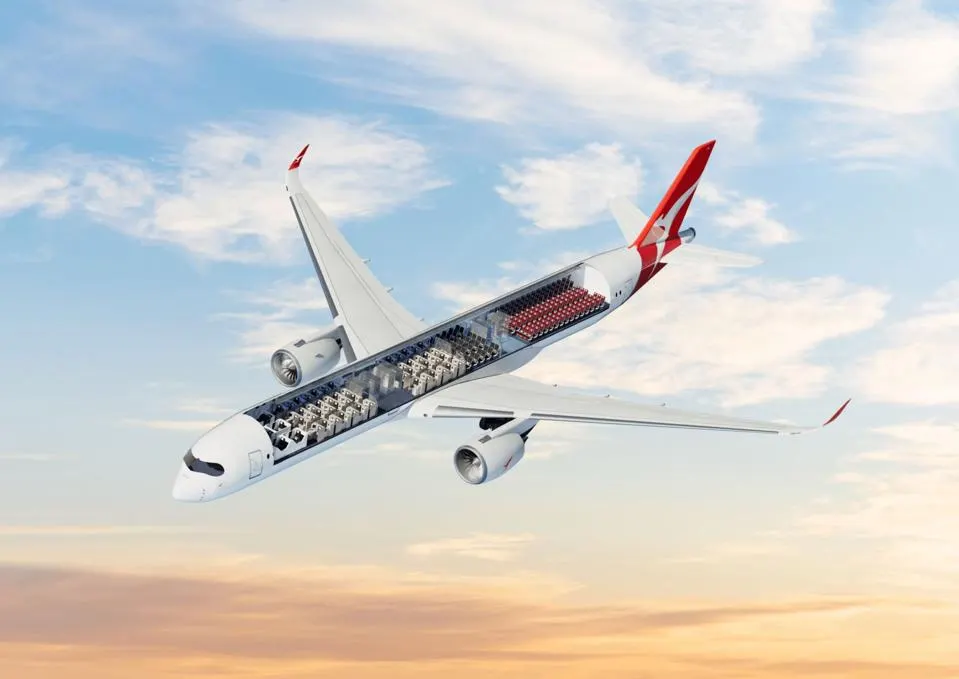“Welcome to Australia in the sky.” That’s the tag line of a Qantas commercial created by filmmaker Baz Luhrmann (Elvis, The Great Gatsby, Moulin Rouge) to kick off the airline’s new brand campaign. And with the airline’s Project Sunrise ultra-long-range flights scheduled for 2026, flyers will be spending up to 20 hours with Australia in the sky.

Qantas has been through a lot over the past few years. COVID devastated the airline, and a number of scandals led to the departure of CEO Alan Joyce. But through it all, Qantas remained fixated on a key project: Project Sunrise.
Vanessa Hudson, who took over as Qantas CEO last year, spoke at an event in a hangar at LAX to celebrate Qantas and the upcoming Project Sunrise non-stop flights from Sydney to London and New York. She said that the project speaks to ‘Australians hunger to fly point to point.’ The upcoming long flights, she said, “are a great way for Australians to break out and see the world on the A350.”
As a Qantas website put it, “Our fleet of specially designed Airbus A350s [will]overcome the tyranny of distance, with the ability to travel between Australia and almost any city in the world.” Qantas is assuring potential flyers that research and design will make the flights comfortable and safe.
Hudson also had some reassurance for Airbus A380 fans. Hudson revealed that the A380 fleet operated by Qantas are getting their final set of updated new seating before they are retired in 6 or 7 years.
Luhrmann, too, sang the praises of Qantas (his new ad features the A380.) He noted, “There’s flying and there’s Qantas. Great Ozzie food and wine. The journey is the destination, in the warm embrace of our Ozzieness.”
As for Project Sunrise, it may indeed be ‘the ultimate in long haul travel.’ The original definition of Project Sunrise was a flight so long that the passengers and crew experience TWO sunrises. Another definition was to create an aircraft capable of flying non-stop between any two points on earth.
Ultimately, the goal was to make the world “closer” to Australians, and make Australia more accessible to visitors, with non-stop direct flights from Australia to the Americas, Great Britain and other destinations.
Qantas began Project Sunrise in 2017, asking Boeing and Airbus to develop ultra-long-range versions of their latest widebody aircraft. The ultimate victor was Airbus. Qantas ordered a dozen ultra-long-range versions of the Airbus A350-1000 that are now expected to arrive in 2026. (Project Sunrise was originally slated to begin in 2022, but the COVID pandemic paused development.)
Meanwhile, the airline gathered data on how passengers, pilots, and cabin crew would manage spending up to 22 hours in the air. Qantas already has experience with long flights, such as the 17-hour nonstop connecting Melbourne and Dallas that made its debut in March 2022.
In standard three-class configuration, an Airbus A350-1000 can accommodate between 300 and 410 passengers. The Qantas A350-1000ULR will carry just 238 passengers up to 22 hours from Australia to almost any destination in the world. This lighter load is to allow space for what Qantas calls its Wellbeing Zone and to give customers more space, as well as for the additional weight of the third fuel tank.
The 238-seat cabin layout includes six first class seats in a 1-1-1 configuration, 52 business class seats in 1-2-1, 40 premium economy seats in 2-4-2 and 140 economy seats in 3-3-3 alignment.

The business class cabin features a 25-inch-wide chair that can be reclined into a two-meter-long bed. Business suites will feature a sliding door and a divider. Qantas even claims the new suites will be 50% more spacious compared to A380 suites.
Economy seating has a relatively generous 33” seat pitch at 33” a multi-use seatback table and a 13.3” entertainment touchscreen. All cabins will get complimentary Wi-Fi.
The first flight between New York and Sydney, Australia, requires an aircraft capable of flying, a distance of 9938 miles. At 19 hours plus, that would be the longest flight in the world. It is almost 500 miles longer than the current record holder, the Singapore Airlines flight from Singapore to New York. That flight is 9,537 miles and takes 18 hours, 50 minutes.
The flights are now set to launch sometime in mid-2026, a date predicated on the aircraft arriving from Airbus. This depends when Airbus can deliver the A350-1000 long range aircraft for the route. This spring it was reported that Airbus had a backlog of 214 A350-1000 aircraft, including a total of 24 for Qantas.
The Airbus A350-1000 variant is being built by Airbus in Toulouse. According to Qantas, the third fuel tank in the ultra-long-range Project Sunrise aircraft was certified by the EASA (the European Union Safety Agency) in June. Qantas is regulated by CASA (Civil Aviation Safety Authority) which will certify the aircraft when it nears arrival in Australia.
Qantas has not yet released details on the number of aircraft it plans to operate on the Sydney-New York route, ticket prices nor the frequency of flights.

Will business and leisure travelers ‘sit still’ for a 20-hour flight? Qantas frequent flyers say they will, as they have an understandable preference for direct (non-stop) flights. A nonstop flight from New York to Sydney would cut travel time from 23 hours (including a change of plane) to 19 hours. Similar time savings could be achieved flying to places like Buenos Aires and Chicago, based on network and customer demand.
However, passengers can’t be expected to ‘sit still’ for an all-day flight, a situation Qantas is trying to address with “Wellbeing First.” Qantas says the cabin interior, the gentle lighting and the service design were all influenced by medical and scientific research carried out on research flights.
The aircraft will also feature Qantas’ first in-flight Wellbeing Zone, located between Economy and Premium Economy cabins. The Wellbeing Zone will have sculpted walls and integrated handles to facilitate standing and stretching. Video screens will guide your movements and offer content on staying healthy. The area will also offer passengers a selection of complimentary healthy refreshments.
According to a spokesperson at the LAX event, “The space will accept between 8 and 10 people for stretching their legs.” And while any passenger can visit the Wellbeing Zone, “It’s primarily for Economy passenger sas they have the least space.”
The stakes are high for Qantas and for Australia itself. Cutting non-stop flight time would make it easier for Americans to visit Australia, and just as important, allow Australians to participate more in the world.

The tyranny of distance still separates Australia from the rest of the globe. While supersonic transport remains on the drawing board, passenger-friendly Project Sunrise may indeed help transcend time and distance.
This article was originally published on forbes.com.


